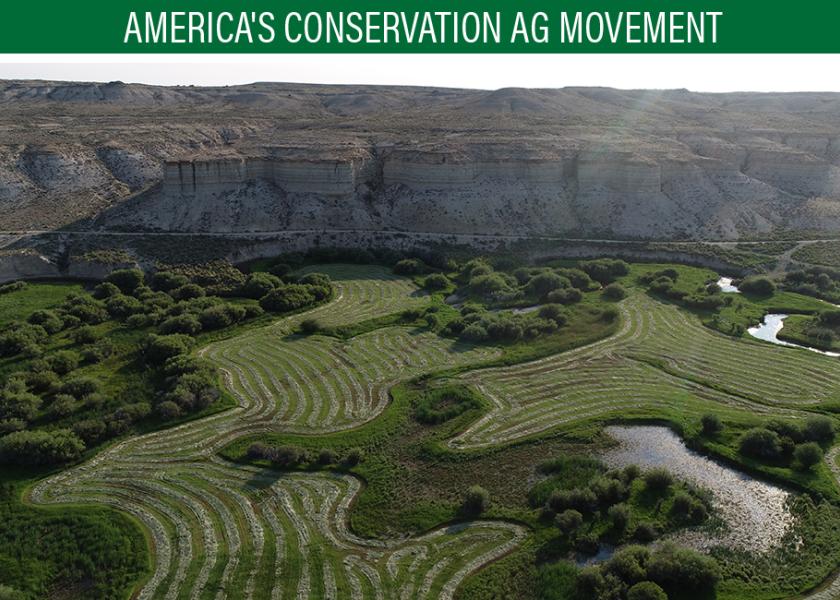Cash For Water Creates Win-Win For Ranchers, Consumers

Building trust in food begins with empowering farmers through one of the largest and most diverse conservation- and sustainability-focused public-private partnerships in our nation’s history: America’s Conservation Ag Movement. To find the latest news and resources related to the Movement, visit AgWeb.com/ACAM.
Water is the lifeblood of hay production and using less is risky in southwest Wyoming, where ranchers are lucky to get one high-quality cutting of hay a year. But that is exactly what Eric and April Barnes decided to do, after being asked by Trout Unlimited (TU) to participate in a four-year, water-management initiative called the System Conservation Pilot Program (SCPP), implemented by the Upper Colorado River Commission.
Eric laughs and acknowledges he was “scared to death” to reduce his water use the first year and trust TU and the commission, but he’s glad he did.
“It opened my eyes that I could still make my hay crop, even with shutting the water off during a critical time of the year,” says Barnes, whose family runs a 300-head, Angus-Simmental ranch near Kemmerer, Wy.
Turning off the water after the first cutting of grass hay between July and October, allowed it to remain in Fontenelle Creek instead of being diverted into irrigation ditches.
The creek flows through the Barnes’ property, joins with the Green River, then merges with the Colorado River and empties into Lake Powell and Lake Mead. The beleaguered river system and lakes supply water to 40 million people in seven states – Arizona, California, Colorado, Nevada, New Mexico, Utah and Wyoming – and help support a $5 billion-a-year agricultural industry, according to the U. S. Bureau of Reclamation (USBR)

Nick Walrath says TU was supportive of the SCPP because it was voluntary for landowners to participate, offered them a strong economic incentive and supported the environment in the process. TU and The Nature Conservancy provided manpower to help applicants, such as the Barnes family, enroll in the program.
“We want to see producers here stay in business; they care about the habitat and keeping the fisheries viable,” says Walrath, TU Green River Project Manager.
The commission – thanks to funding from the USBR, the Walton Family Foundation and a number of municipalities – compensated participating ranchers and farmers between $150 and $200 per acre foot for the water they didn’t use. The program is just one example of the many ways various organizations and environmental groups have worked with farmers and ranchers recently in an effort to enhance water conservation.
A Step Of Faith: At face value, signing on for the SCPP might sound like an easy decision. But it required a huge mental shift for cattlemen and farmers who are based in the dry foothills of the central Rocky Mountains, an area that receives only 5” to 10” of rain each year.
“Producers here in the arid West feel they need to use all the water they have access to in order to protect their water rights,” Walrath says. “It was a hard sale at times over a lot of cups of coffee.”
Barnes adds that the short growing season combined with little rain can cause cattlemen to miss out on their entire hay crop, creating a crisis for ranching families who are already working hard to deal with low commodity prices and a harsh environment.
Walrath says only the Barnes family and three other ranchers he works with signed on in the first year of the program. But after seeing their success, additional Wyoming ranchers signed on with a total of 22 participating in the fourth and final year of the initiative, which wrapped up in 2018. In addition to Wyoming participants, some ranchers and farmers in Colorado, New Mexico and Utah joined the program as well.
“This program helped me see that I needed to use my water more effectively across our hayfields – to be very deliberate in how I irrigate when the creek is high, to grow that first cutting of hay,” Eric says. “That’s what I continue to focus on now.”
Walrath says he is hopeful that the program – or a similar one – will be continued at some point, as the funding strategy was a win-win for ranchers, the huge population base and wildlife living in the hot, dry region.
“There's possible opportunity where folks that are willing to pay for wildlife values come in and pay for that late-season flow to keep the fisheries viable,” Walrath says. “And that number, what they’re willing to pay, might be more than the water’s worth on the field for at least in the late season.”
Initiatives Tracking Beef's Sustainability
Crop Tour 2020 is On, Virtual Meetings Open to All







